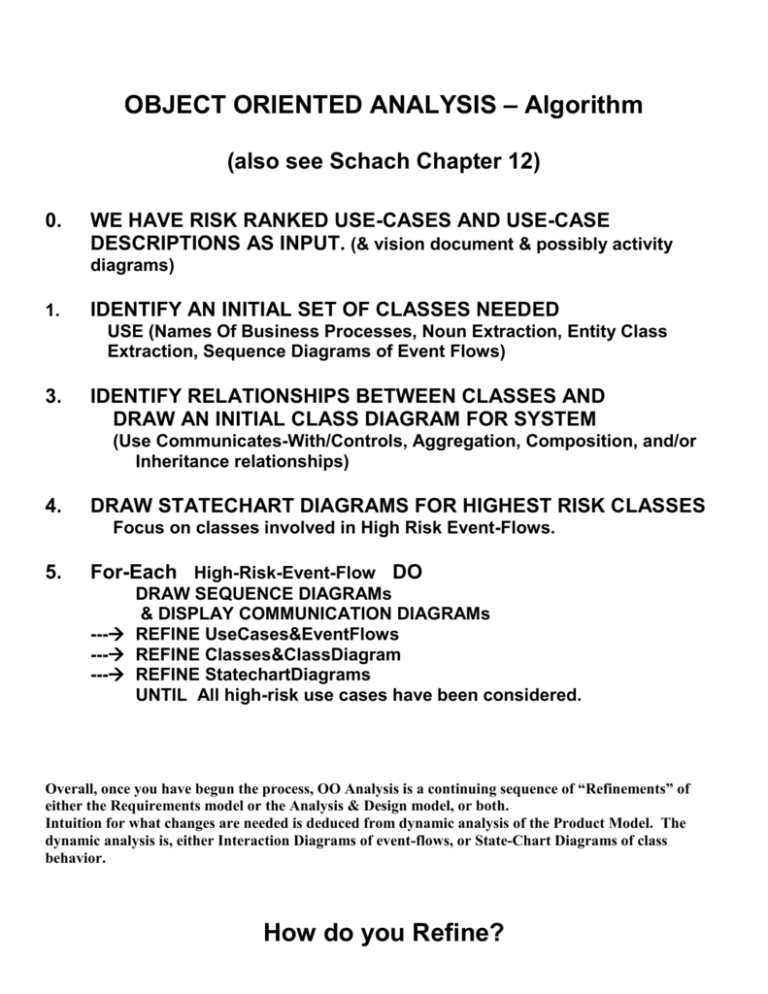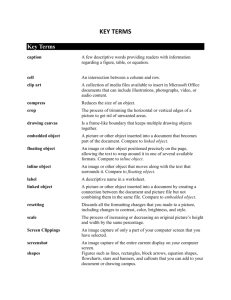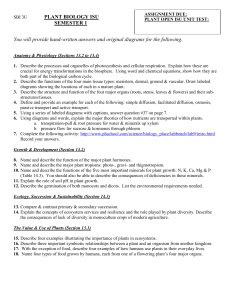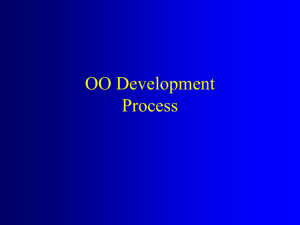OBJECT ORIENTED ANALYSIS – Algorithm
advertisement

OBJECT ORIENTED ANALYSIS – Algorithm (also see Schach Chapter 12) 0. WE HAVE RISK RANKED USE-CASES AND USE-CASE DESCRIPTIONS AS INPUT. (& vision document & possibly activity diagrams) 1. IDENTIFY AN INITIAL SET OF CLASSES NEEDED USE (Names Of Business Processes, Noun Extraction, Entity Class Extraction, Sequence Diagrams of Event Flows) 3. IDENTIFY RELATIONSHIPS BETWEEN CLASSES AND DRAW AN INITIAL CLASS DIAGRAM FOR SYSTEM (Use Communicates-With/Controls, Aggregation, Composition, and/or Inheritance relationships) 4. DRAW STATECHART DIAGRAMS FOR HIGHEST RISK CLASSES Focus on classes involved in High Risk Event-Flows. 5. For-Each High-Risk-Event-Flow DO DRAW SEQUENCE DIAGRAMs & DISPLAY COMMUNICATION DIAGRAMs --- REFINE UseCases&EventFlows --- REFINE Classes&ClassDiagram --- REFINE StatechartDiagrams UNTIL All high-risk use cases have been considered. Overall, once you have begun the process, OO Analysis is a continuing sequence of “Refinements” of either the Requirements model or the Analysis & Design model, or both. Intuition for what changes are needed is deduced from dynamic analysis of the Product Model. The dynamic analysis is, either Interaction Diagrams of event-flows, or State-Chart Diagrams of class behavior. How do you Refine? IDEAS FOR REFINEMENT 1. Keep As Much As Possible Private! 2. Choose the Strongest Relationships Between Classes that are Appropriate! COMMUNICATES WITH relationships: AGGREGATION relationships: COMPOSITION (has-a) relationships: INHERITANCE (is-a) relationships: ______ ______ ______ ______ Weakest Collection Stronger Strongest 3. Data Encapsulation: Classes should create needed abstractions. (i.e. JobQueue class, with operations Add/Delete Job) 4. Information Hiding: Before a product is designed, a list should be made of Implem. decisions that are likely to be made in the future. Classes should be designed so that implem. details are hidden from other classes. 5. Separation of Concerns | Divide & Conquer: Large problems should be subdivided into a collection of smaller problems that can be solved individually. 6. Cohesion: Is an indication of the relative functional strength of a class or object. Functional strength is very desirable. 7. Coupling: Is an indication of the amount of interconnection between classes or objects. A high degree of interconnection between classes (or objects) is very undesirable. 8. Responsibility Driven Design: is an informal method for optimally dividing and arranging an applications responsibilities among objects and for coordinating their cumulative performance. RESPONSIBILITY DRIVEN DESIGN (RDD) (Object Design: Roles, Responsibilities, and Collaborations, Rebecca Wirfs-Brock and Alan McKean, Addison Wesley, 2003) ROLES AND RESPONSIBILITIES: Role: A role is a set of related responsibilities. Just as an actor plays a part in a play, an object takes on a character in an application by assuming responsibilities that define a meaningful role. Typical role-stereotypes include: Information Holder: Structurer: Service provider: Coordinator: Controller: Interfacer: (i.e., What role does the object play?) knows and provides information maintains relationships between objects and information about those relationships performs work, & in general, offers computing services reacts to events by delegating tasks to others makes decisions and closely directs other’s actions transforms information and requests between distinct parts of our system Two different objects can play the same role and satisfy the same responsibilities, but have a different implementation. Objects that play the same role can be interchanged. For example, there are several providers that can deliver letters and packages: DHL, FedEx, UPS, USPO, & Airborne. They all have the same purpose, but not the same way of carrying out their business. You chose from among them according to the requirements you have for delivery. (One day, book rate, flammable?) You pick the mail carriers that meet your requirements. It is useful to think about an object, asking, “What role does it play?” This helps us concentrate on what it should be and what it should do. Object roles refer to an exterior view of what general service is offered by the object. Object responsibilities refer to a more detailed interior view of the service offered. Note, that the “interior” view does not specify the details of an implementation. Indeed, different implementations of these responsibilities are possible. What are responsibilities? Responsibilities are general statements about software objects that include: 1. the actions an object performs, 2. the knowledge an object maintains, and 3. major decisions an object makes that affect other objects. How to optimally distribute individual responsibilities between objects is often the most difficult problem in object design. COLLABORATION: An application implements a system of responsibilities. Responsibilities are assigned to roles. Roles collaborate to carry out their responsibilities. To collaborate is to work together, especially, in a joint intellectual effort. We start design of an application by inventing objects, assigning responsibilities to them for knowing information and for doing the applications work. Collectively, these objects work together to fulfill the larger responsibilities of the application. One object calls on, or collaborates with, another because it needs something. Both parties are involved. One needs help, the other provides a service. Designing collaborations forces us to consider objects as cooperating partners and not as isolated individuals. Design is an iterative and incremental process of envisioning objects and their responsibilities and inventing flexible collaborations within small neighborhoods. OBJECTS AND THEIR RESPONSIBILITIES PROVIDE THE COMMON CORE FOR THE RDD PROCESS. A DESIGN/(ANALYSIS) MODEL ARRANGES RESPONSIBILITIES AMONG OBJECTS. RESPONSIBILITY DRIVEN DESIGN R.Wirfs-Brock (Summary) If a client sends a message to an object, then that object is responsible for every aspect of carrying out the request of the client. The client does not know, and is not permitted to know, how the request will be carried out. Once the request has been carried out, control returns to the client. At this point, all the client knows is that the request has been carried out; it has no idea how this was achieved. This is the kernel of the idea of “responsibility driven design.” Form a users point of view (and a maintainers point of view) client objects ONLY know that a request can be carried out but NOTHING about how! This basic requirement that the only public knowledge of objects is what service they can perform, can be used to “refine” the set of (Analysis) classes and to Design their attributes and methods. Thinking of software products as a balanced community of such objects can provide especially valuable insight into the Analysis task. OBJECT-ORIENTED SOFTWARE IS A COMMUNITY OF OBJECTS. IN THIS COMMUNITY, EACH CITIZEN PROVIDES INFORMATION AND COMPUTING SERVICES TO A SELECT GROUP OF ITS NEIGHBORS. THE DESIGN OF WELL FORMED PATTERNS OF COLLABORATION LIES AT THE HEART OF ANY OBJECT DESIGN. CHARACTERISTICS OF GOOD OBJECTS. As we conceive our design, we must constantly consider each objects value to its immediate neighborhood. Does it provide a useful service? Is it easy to talk to? Is it a pest, because it is constantly asking for help? Are its effects the desired ones? Does it stick to its purpose? Are its responsibilities clearly stated? Do its responsibilities match its role? Is it of value to other objects in its neighborhood? The fewer demands an object makes, the easier it is to use. The more it can take on, the more useful it is. An object can be more intelligent if it does something with what it knows. The smarter it gets, the fewer details a client must know to use its services. Making objects smarter has the net effect of raising the IQ of the whole neighborhood.







